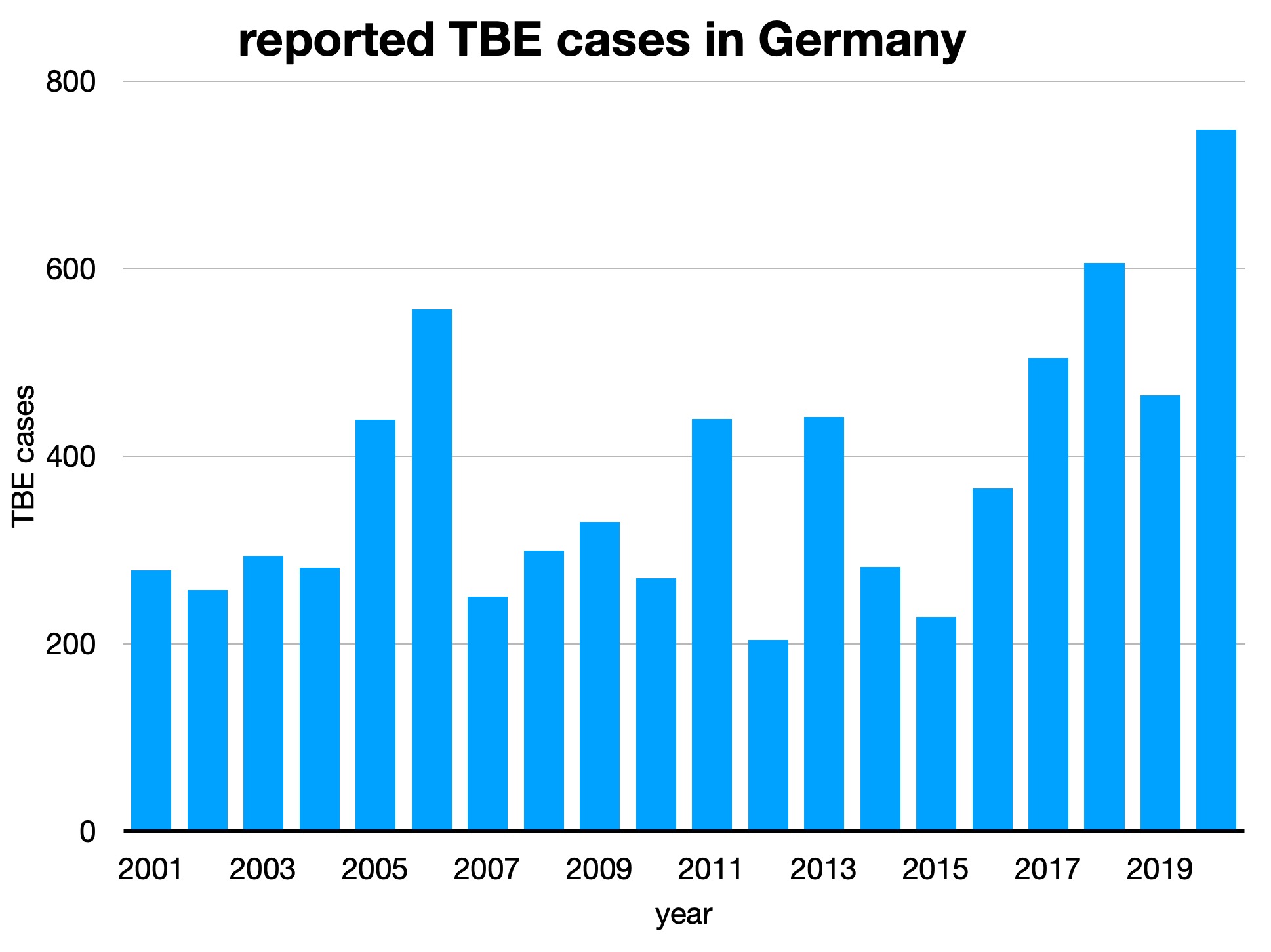Actually, walks in the fresh air in nature are something good and especially in the lockdown many people have rediscovered taking a walk for themselves. Unfortunately, however, ticks also lurk in nature, which can act as carriers of Tick-borne encephalitis (TBE). In 2020, the number of reported TBE cases in Germany was higher than ever before.

Tick-borne encephalitis (TBE) is a tick-borne disease that causes no or mild symptoms in most people (about 70 to 95%). However, some may experience neurological manifestations of TBE (meningitis, encephalitis, myelitis). In these rare severe courses, there is a risk of permanent neurologic deficits. In about 1% of severely affected persons, the disease can be fatal. TBE is triggered by a virus. The TBE viruses can enter the human bloodstream through a tick bite, multiply in the body and thus trigger the disease. (You can find more information on the virus in our "Zoonosis of the month" section).
The numbers of reported TBE cases in humans in Germany have mostly fluctuated between 200 and 600 cases per year in recent years. In 2020, however, the number was higher than at any time in recent years, with 748 reported cases (see Fig. 1).
How did this high number of cases occur in 2020 and how can one protect oneself against infection? We talked about these questions with Prof. Dr. Gerhard Dobler, member of the Internal Advisory Board of the Zoonoses Platform and Head of the Department of Virology and Rickettsiology at the Institute of Microbiology of the German Bundeswehr in Munich.
Mr. Dobler, what factors do you think led to such a high number of TBE cases being reported last year?
Dobler: A number of unfavorable factors came together in 2020: For one, we had high tick populations in the spring. This coincided with the fact that there appears to have been a lot of TBE virus in the ticks. Last but not least, due to the lockdown, people were out in nature a lot at the time of the highest tick activity (May, June) and exposed themselves there. Walking in nature increases contact with nature and thus with ticks. This leads to an increased risk of infection. We assume that this was an important reason for the high infection numbers last year.
In which areas of Germany can I become infected with TBE? Does the TBE virus occur everywhere in Germany?
Dobler: TBE occurs in increased activity throughout southern Germany (Bavaria, Baden-Württemberg, Thuringia, Saxony, parts of Hesse). Individual cases also occur in the other federal states (see also the Robert Koch Institute's map of TBE risk areas in Germany). I am talking here about a low activity of the TBE virus. I do not think that there is a region in Germany that can be said to be guaranteed TBE-free.
Besides TBE, Lyme disease is another tick-borne disease. Do the number of reported TBE and Lyme disease cases in Germany correlate with each other?
Dobler: Unfortunately, we only have incomplete figures for Lyme disease. Many Lyme diseases are not diagnosed microbiologically, but clinically. There is always a certain degree of uncertainty. In contrast, we have very reliable figures for TBE. Last year, the number of reports of Lyme disease in southern Germany also increased significantly. This means that there is certainly a connection in the number of infections via the vector, the tick.

Fig. 2: Walks in nature are a popular leisure activity. However, protection against tick bites should not be forgotten.
What is the best way to protect yourself from infection?
Dobler: It is important to be aware that ticks are everywhere in nature. When spending time in nature, we recommend wearing long light-colored pants with the legs tucked into the socks to give the ticks as little surface to attack on the skin as possible. On light fabrics the dark ticks can be detected very well and removed before they reach the skin. After spending time in nature, you should carefully check for ticks, as ticks often search for a suitable bite site on the skin for several hours. In case of a tick bite, the tick should be removed immediately. The bite site should then be observed for several weeks and a doctor should be consulted if a red spot appears. In the risk counties designated by the Robert Koch Institute, TBE vaccination is recommended for all persons who spend time in nature. Outside the known TBE risk areas, TBE vaccination should be performed by the physician in case of increased individual risk or travel risk.
Interview: Dr. Dana Thal, German Research Platform for Zoonoses
Further links (in German):
Zoonose des Monats Februar 2020 – FSME
Informationen des Robert Koch-Instituts zu FSME
Karte der FSME-Risikogebiete in Deutschland des Robert Koch-Instituts




